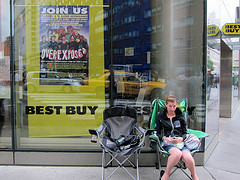Best Buy VP Tells Consumerist Why He Thinks The Company Can Still Compete

(Scoboco)
Consumerist recently spoke with Matt Furman, Best Buy’s Chief Communications Officer and Senior Vice President of Public Affairs, about whether or not the electronics retailer can compete in a world where a shopper can go online and buy a TV from Amazon and other online-only sellers, but also buy clothing, furniture, detergent, and food in the same purchase.
“We view both our online capability and our physical footprint as being unique in the world of consumer electronics,” explained Furman. “We are a true multichannel retailer… You can order online from us and you can pick it up in store on the same day. You can’t do that from anybody else.”
This notion is in line with what the company stated last week when it announced surprisingly positive quarterly earnings that included not just a bump in comparable store sales (after many quarters of negative sales growth in this category), but a sizable 11% increase in online sales. In speaking about the upcoming year, new CEO Hubert Joly emphasized online growth as the top of several priorities, along with “escalating the multichannel customer experience,” referring to the company’s ability to sell to both online customers and bricks-and-mortar shoppers.
To that end, Furman pointed to the store’s army of “Blue Shirts,” on-the-floor retail employees who Best Buy is banking on as being a difference-maker in winning over customers.
“You can come in and have impartial, knowledgeable advice given to you by Blue Shirts in a way that you can’t find anywhere else,” he says. “Of course, if you have any service or installation needs, you’ve got the Geek Squadders at the ready to help you.”
When we mentioned that a not-small number of Best Buy-related complaints we receive mention these same employees as being part of the problem, Furman countered that the company only recently began implementing a new operating model that “for the first time included a level of training and, just as importantly, coaching for every Blue Shirt in our stores.”
He adds that this training isn’t just for new employees, but that it’s an ongoing process for all retail staffers.
And, explains Furman, since Joly’s attitude for management is “all hands on deck,” the company has asked corporate employees and regional supervisors who began their Best Buy careers as Blue Shirts to venture back on the retail floor. Joly himself got a taste of on-the-job experience after he stepped into the CEO gig last fall.
“Asking our territory and district managers to go back into the store and again, give their time as additional customer facing labor,” says Furman. “There is a palpable feeling that the transformation is beginning and is already beginning to take root. That requires all hands on deck.”
Best Buy has made no secret of its plan to save hundreds of millions of dollars over the coming years, and just recently announced that 400 people in the Richfield, MN, corporate HQ would be dismissed.
Furman tells Consumerist that most of the savings will come from making the company more efficient and that cutting head count is the last option, but it’s not outside the realm of possibility.
“In the end, one of our two main problems is declining operating income, or declining margins,” he explains. “And in order to fix that problem, you have to raise revenue, which we’re working on, and you have to lower costs. And that’s the reality of the business we’re in.”
And while Furman wouldn’t make predictions about where the company will be in the long-run, he did say, “the absolute goal is to become even more effective as a multichannel player by improving our stores and by increasing substantially the market share we enjoy in our online business.”
We’d love to hear from Best Buy retail employees to see whether you think the company’s initiatives are working. Feel free to let us know at tips@consumerist.com.
Want more consumer news? Visit our parent organization, Consumer Reports, for the latest on scams, recalls, and other consumer issues.

